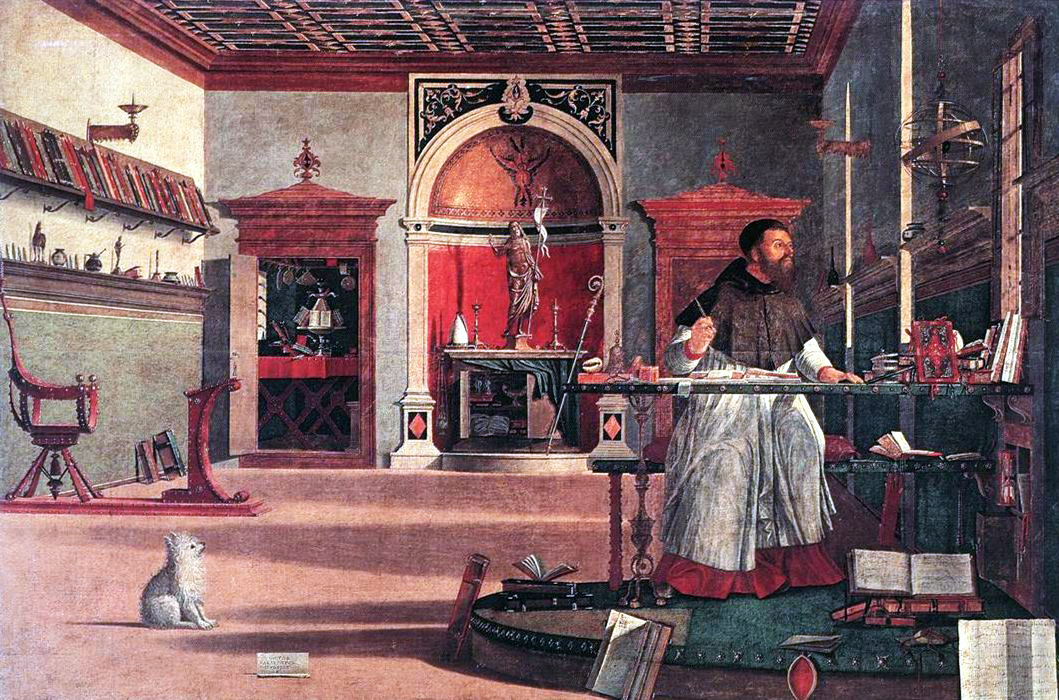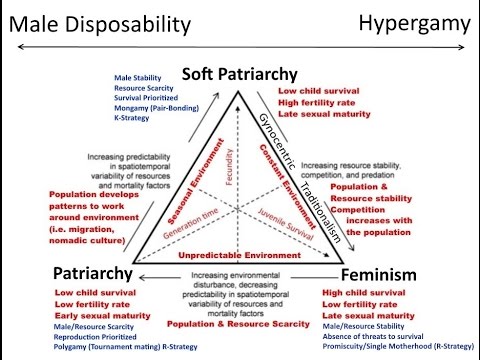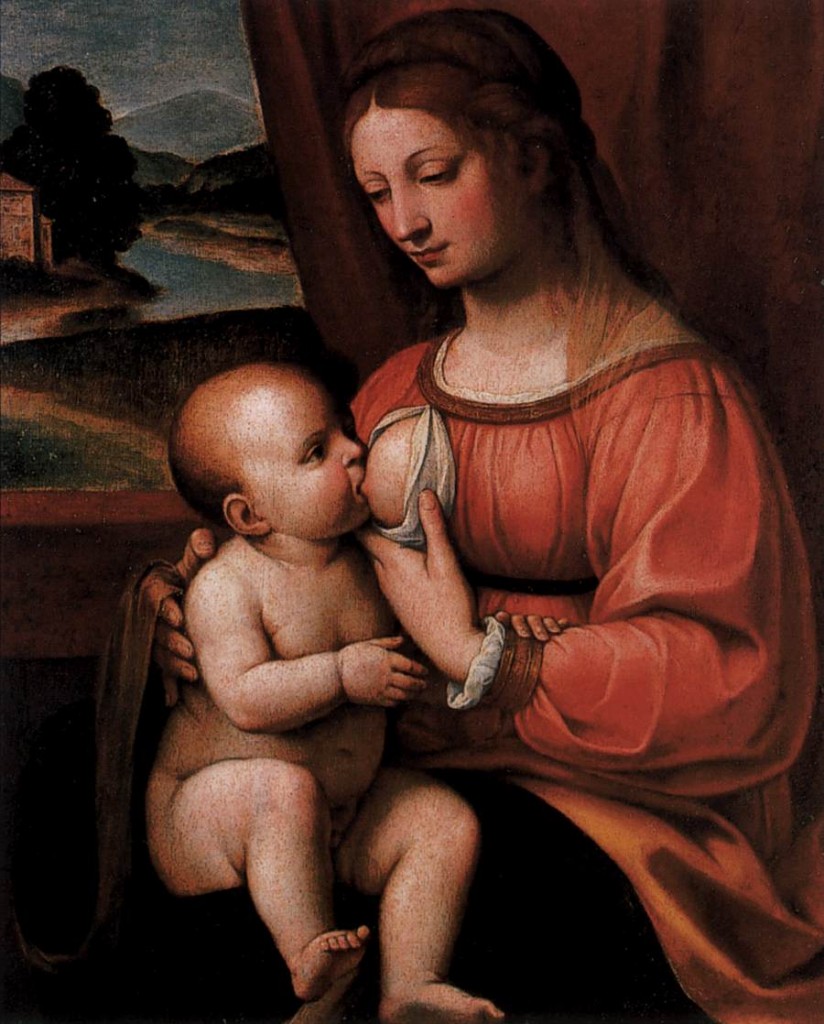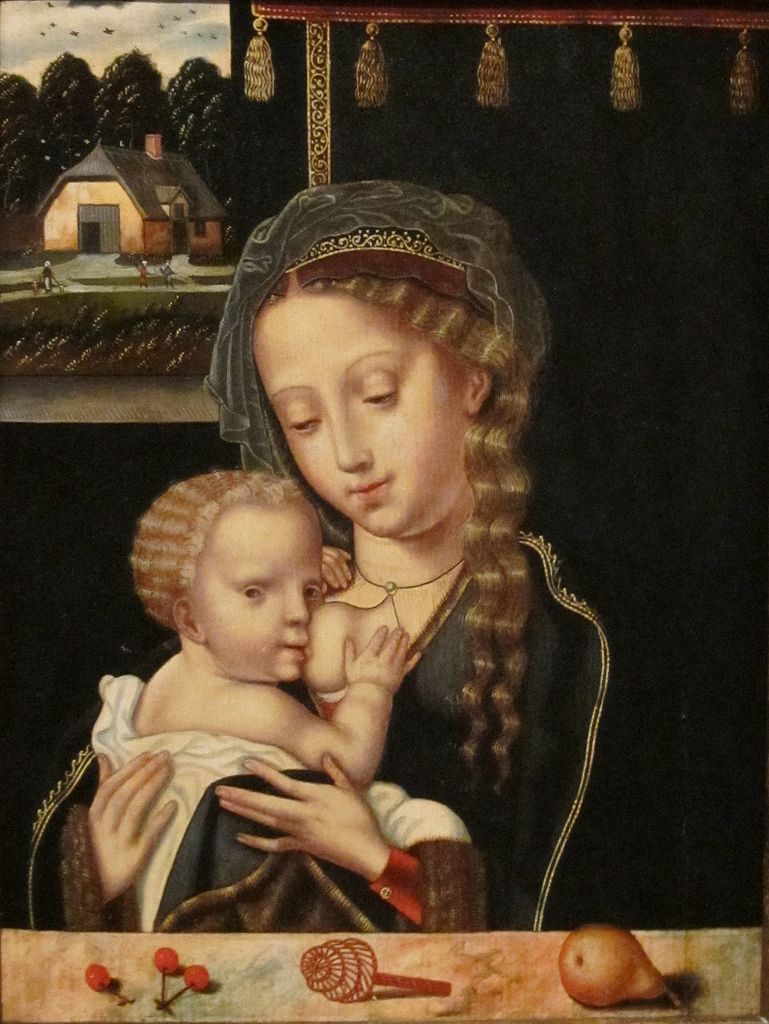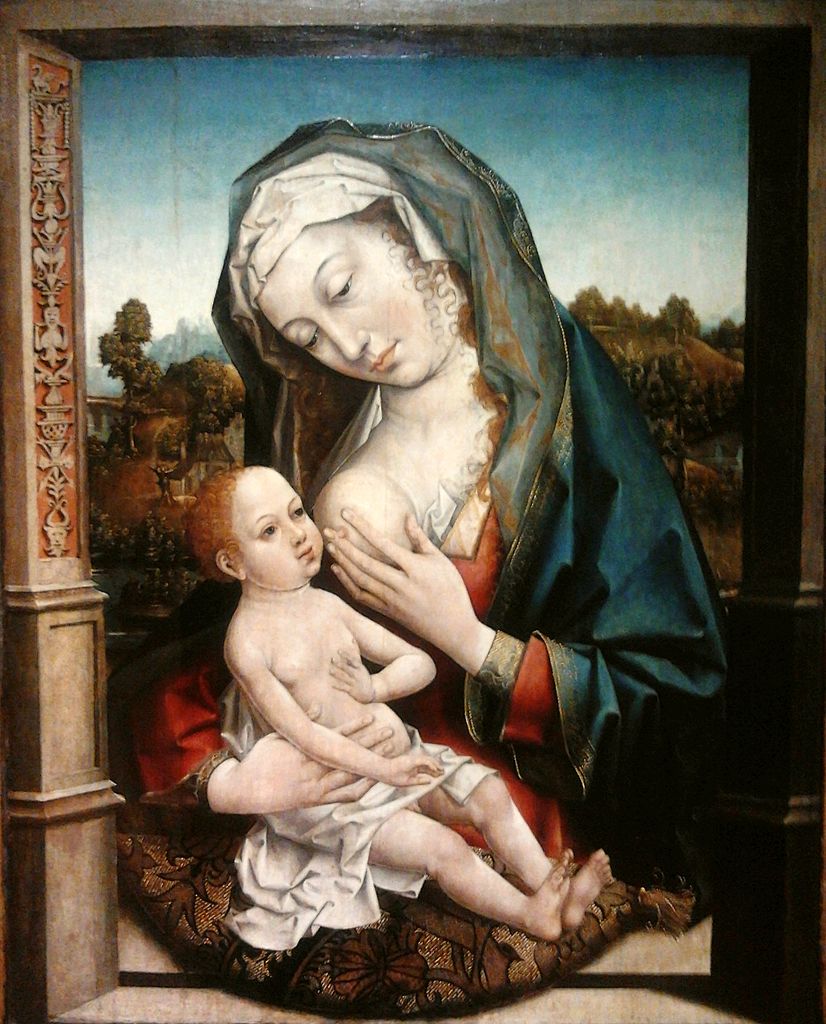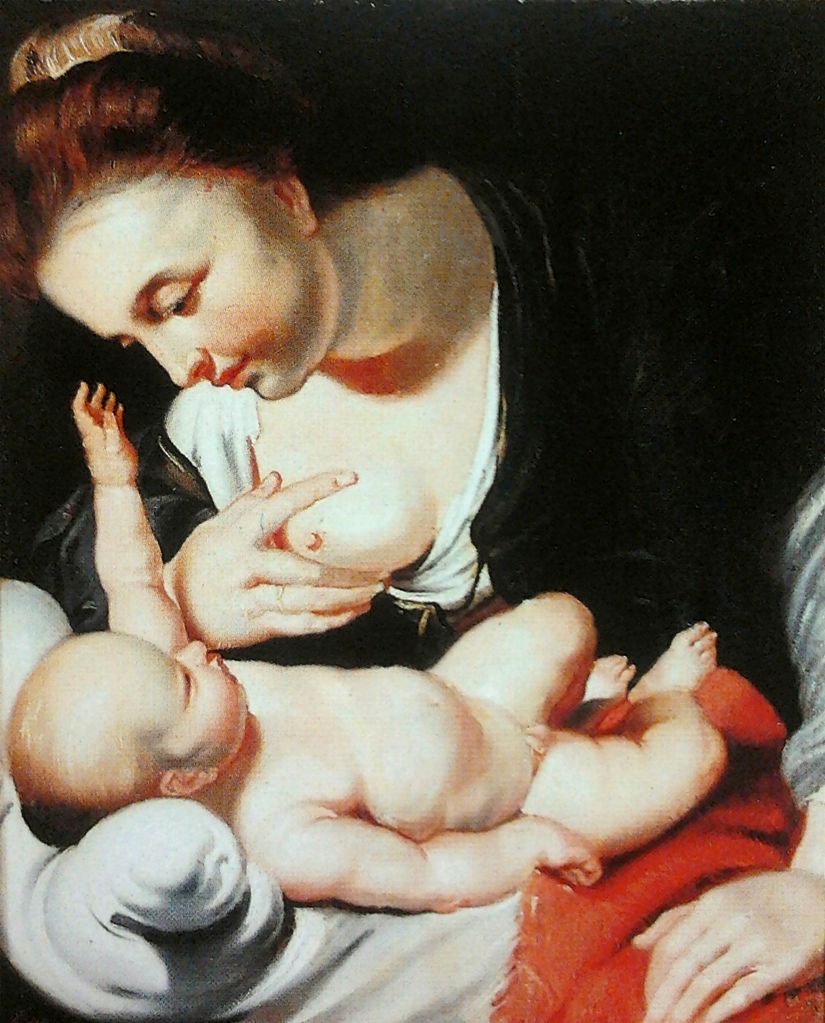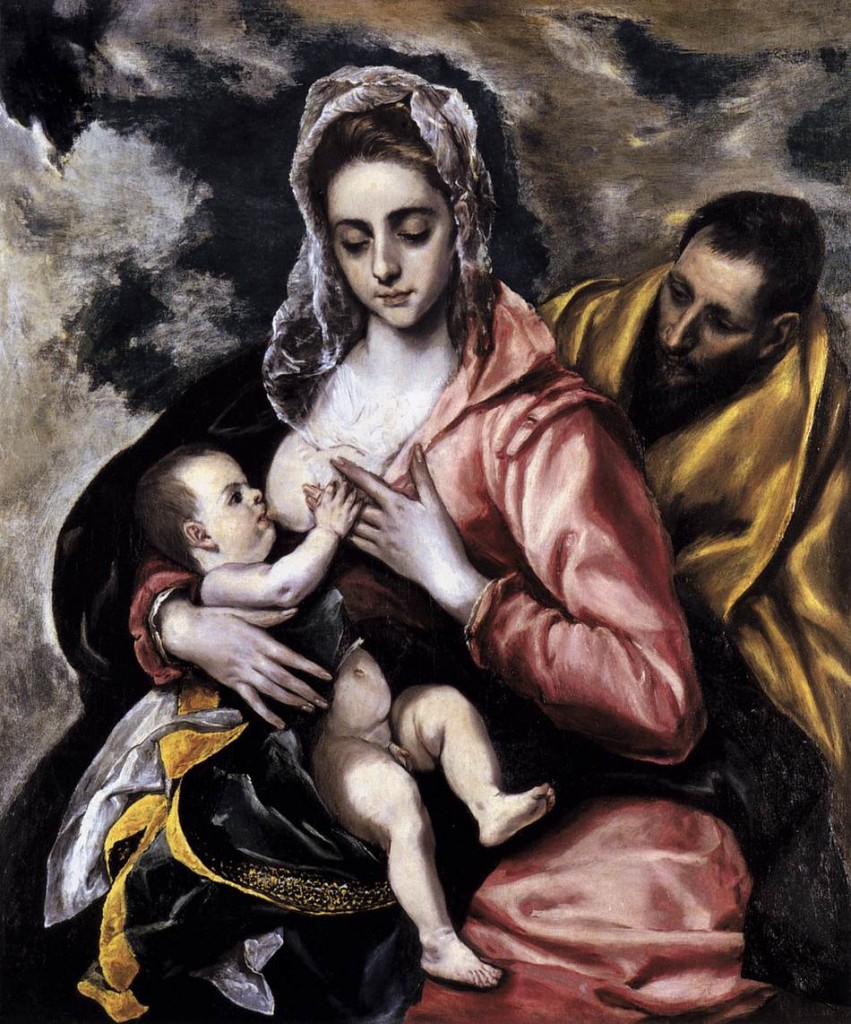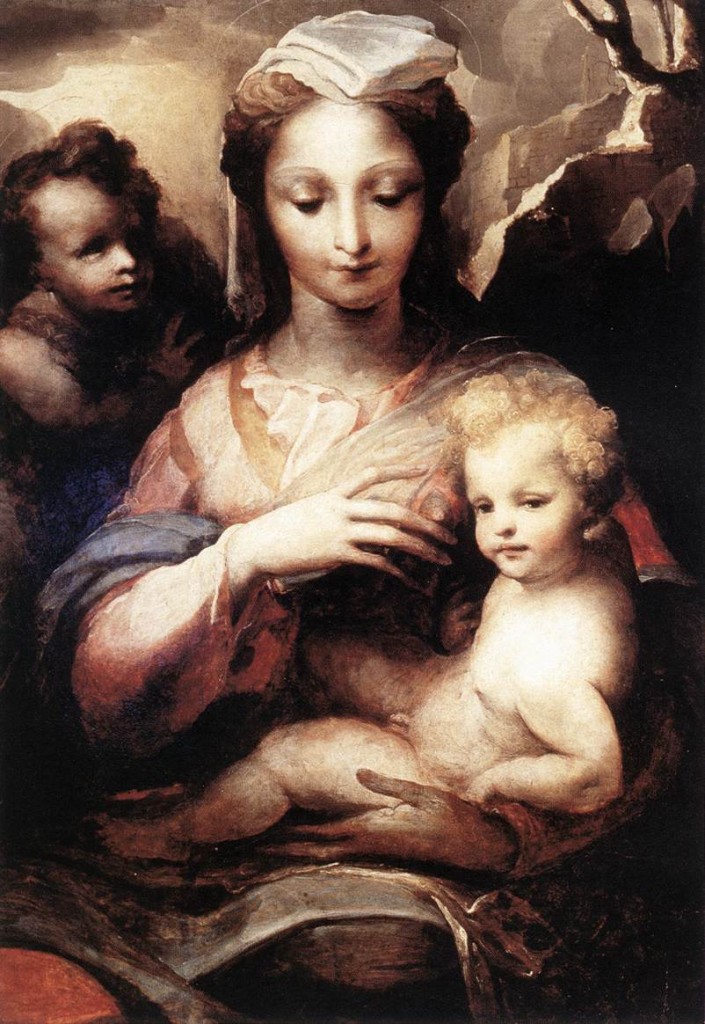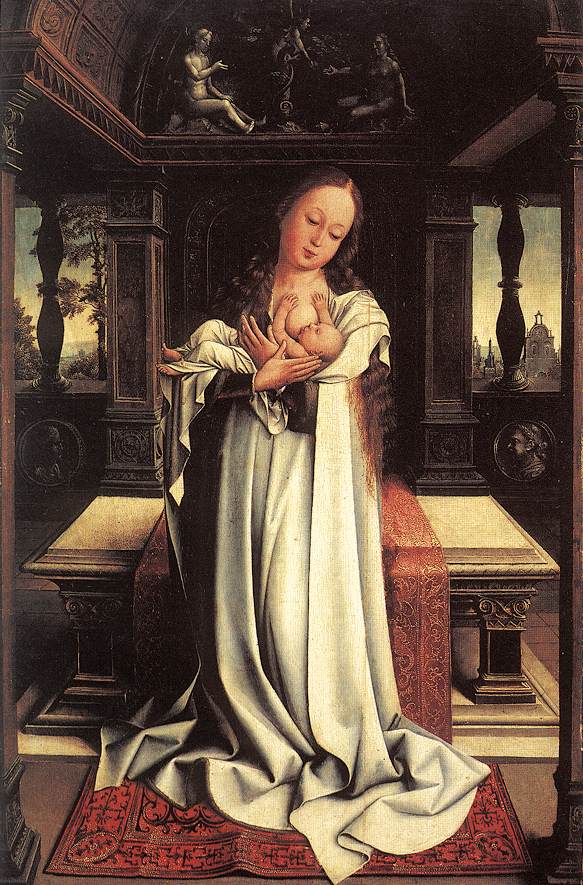Detail of Perdita by Anthony Frederick Sandys, circa 1866
Category: Painting
Christ and the rich young ruler

Saint John the Evangelist, a painting by the Italian Baroque painter Domenichino. The problem with the splendid Christian art is that the painters have Nordicized the Semites of the 1st century. Had photography existed in the 1st century of our era, the Aryans would never have projected their beautiful physiques on the ugly rabble of Palestine.
______ 卐 ______
Neither the Gospel of Matthew, nor the Gospel of John, nor John’s Book of Revelation come from the apostles to whom the Church attributes them
Due to the great importance of the ‘apostolic tradition’, the Catholic Church published all the Gospels as books of the apostles or their disciples, which justified their prestige. But there is no proof that Mark and Luke, whose names appear in the New Testament, are disciples of the apostles; that Mark is identical to the companion of Peter, or that Luke was Paul’s companion. The four Gospels were transmitted anonymously.
The first ecclesiastical testimony in favour of ‘Mark’, the oldest of the evangelists, comes from Bishop Papias of Hierapolis, in the middle of the 2nd century. But today there are many researchers who criticise the testimony of Papias; call him ‘historically worthless’ (Marxsen), and even admit that Mark ‘has never heard and accompanied the Lord’.
The apostle Matthew, a disciple of Jesus, is not the author of the Gospel of Saint Matthew which appeared between the 70s and 90s, as is generally assumed. We ignore how he got the reputation of being an evangelist. It is evident that the first testimony comes from the historian of the Church, Eusebius, who in turn accepted the claim of Bishop Papias: about whom he writes that ‘intellectually, he should have been quite limited’. The title ‘Gospel of Matthew’ comes from a later period: we find it for the first time with Clement of Alexandria and Tertullian. Both died at the beginning of the 3rd century. If the apostle Matthew, contemporary of Jesus and witness of his works, had written the Gospel that is attributed to him, would he have had to borrow so heavily from Mark? Was he so forgetful? Did he have so little inspiration?
All critical biblical research considers that there is no reason why the name of the apostle Matthew should appear on the Gospel, since it was not written in Hebrew, as the tradition of the ancient Church affirms, but in Greek. No one is known to have seen the Aramaic original, nor is anyone known to have translated it into Greek; nor in the manuscripts or citations is the slightest remnant of an original Aramaic text preserved. Wolfgang Speyer rightly includes the Gospel of Matthew among ‘fakes under the mask of religious revelations’. K. Stendhal ventures that it is not even the work of a single person but of a ‘school’. According to an almost unanimous opinion of all the non-Catholic researchers of the Bible, that gospel is not based on eyewitnesses.
The most recent Catholic theologians often painfully turn on these facts. ‘In case our Greek version of the Gospel of Matthew had been preceded by an original version in Aramaic…’ writes K. H. Sohelkle. Of course, ‘in case’, says Hebbel with irony, is the most Germanic of the expressions’.
‘An original Aramaic Matthew must have been written several decades before the Greek Matthew’. Not even they themselves believe this. Lichtenberg was not the first to know but was the first to say it accurately: ‘It is clear that the Christian religion is supported more by those people who earn their bread with it than by those who are convinced of its truth’.
It is interesting that the first three Gospels were not published as apostolic, the same as the Acts of the Apostles, whose author we also ignore. The only thing we know is that he who wrote these Acts of the Apostles simply puts on the lips of his ‘heroes’ the most appropriate phrases: something common in old historiography. But these inventions not only constitute a third part of the Acts of the Apostles but are also their most important theological content and, what is particularly remarkable, the writing of this author represents more than a quarter of the entire New Testament. It is generally supposed that the author of the Gospel of Luke is identical to the travelling companion and ‘beloved physician’ of the apostle Paul. But neither the Gospel of Luke nor the Acts of the Apostles are very Pauline. Researchers do not believe today that either of these two works was written by a disciple of Paul.
The Acts of the Apostles and the three Gospels were not signed with the true name or even with pseudonyms: they were anonymous works like many other proto-Christian works, such as the Epistle to the Hebrews of the New Testament. No author of the canonical Gospels cites his name, not once does he mention a guarantor, as the later Christian treatises so often do. It was the Church the first to attribute all these anonymous writings to certain apostles and their disciples. However, such attributions are ‘hoaxes’, they are a ‘literary deception’ (Heinrici). Arnold Meyer notes that ‘with certainty only the letters of the apostle Paul are authentic, who was not an immediate disciple of Jesus’. But it is well known that not all those epistles that appear under his name come from Paul.
John
Since the end of the 2nd century, from Irenaeus, although at first not without controversy, the Church attributes without reason the fourth Gospel to the apostle John: something that all critical researchers have questioned for more than two hundred years. There are many weighty reasons for raising questions.
Although the author of this fourth Gospel, who curiously does not mention any author, affirms having leaned on the chest of Jesus and being a reliable witness, he assures and repeats emphatically that his ‘testimony is true’, that ‘he has seen’ and that he ‘knows’ he is telling the truth so that we ‘may believe’. But this Gospel did not appear until about the year 100, while the Apostle John had been killed long ago, towards the year 44 or, probably, in 62.
The Father of the Church, Irenaeus, who was the first to affirm the authorship of the apostle John, has intentionally confused him with a priest, John of Ephesus. And the author of the second and third epistles of John, which are also attributed to the apostle John, calls himself at the beginning, ‘the presbyter’ (a similar confusion also occurred between the apostle Philip and the ‘deacon’ Philip). Even Pope Damasus I, in his canonical index (382), does not attribute two of John’s epistles to the apostle John, but to ‘another John, the presbyter’. Also, even the Father of the Church Jerome denied that these second and third epistles belonged to the apostle. The arguments against the authorship of the apostle John as ‘the Evangelist’ are so numerous and convincing that even Catholic theologians are starting to manifest, little by little, their doubts.
The same could be said about the Book of Revelation of John, whose author is repeatedly called John both at the beginning and at the end of the book, who also appears as a servant of God and brother of Christians, but not as an apostle. The book was written, according to the doctrine of the ancient Church, by the son of Zebedee, the apostle John, since an ‘apostolic’ tradition was needed to guarantee the canonical prestige of the book. But it did not last long given that the Book of Revelation, which appeared in the last place of the New Testament, was rejected by the end of the 2nd century by the critics of the Bible who otherwise did not deny any dogma.
Pope Dionysius of Alexandria (died 264-265), a disciple of Origen and nicknamed ‘the Great’, categorically denied that John was the author of the Apocalypse. Pope Dionysius points out that primitive Christians have already ‘denied and completely rejected’ the ‘Revelation of John’.
They challenged each and every one of the chapters and declared that the work lacked meaning and uniqueness and that the title was false. They affirmed, in particular, that it did not come from John and that they were not revelations since they were surrounded by a multitude of incomprehensible things. The author of this work was not one of the apostles, no saint and no member of the Church, but Cerinthus, who wanted to give a credible name for his forgery and also for the sect of his own name.
The theologian and Protestant bishop Eduard Lohse comments: ‘Dionysius of Alexandria has very accurately observed that the Revelation of John and the Fourth Gospel are so far apart in form and content that they cannot be attributed to the same author’. The question remains whether the author of the Book of Revelation wanted to suggest, by his name John, to be considered a disciple and apostle of Jesus. He does not say that explicitly: it was done by the Church to confer apostolic authority and canonical prestige on his text. And so falsifications started: the falsifications of the Church.
______ 卐 ______
Liked it? Take a second to support this site.
Sant’Agostino nello studio by Vittore Carpaccio (1502)
‘Genius in all fields of Christian doctrine’
[Augustine] often dictated at the same time discussions to several writings: 93 works or 232 ‘books’, he says in the year 427 in his Retractationes (which critically contemplate, so to speak, his work in chronological succession), to which we must add the production of his last years of life, in addition to hundreds of letters and sermons, with which he ‘almost always’ felt dissatisfied.
The intellectual production of Augustine was overrated, particularly from the Catholic side. ‘An intellectual giant like him, only the world offers it once every thousand years’ (Görlich). Maybe from the Catholic world! However, what he calls ‘intellectual stature’ is what serves him, and what serves him is detrimental to the world.
Augustine’s existence precisely reveals it drastically. However, J.R. Palangue praises him as ‘a genius in all fields of Christian doctrine’. And Daniel-Rops goes on to say: ‘If the word genius has any meaning, it is precisely here. Of all the gifts of the spirit that can be fixed analytically, none was missing; he had all, even those that are generally considered mutually exclusive’. Who is startled by such nonsense is called malevolent, malicious, ‘a creeping soul’ (Marrou). However, even the father of the Church Jerome, although out of envy, called his colleague ‘a little latecomer’. In the 20th century, the Catholic Schmaus flatly denies Augustine’s genius as a thinker.
The thought of Augustine? It is totally dominated by ideas of God, partly numbed by euphoria, partly terrified. His philosophy is, basically, theology. From an ontological point of view, it is based on hypotheses without any foundation. And there is a multitude of painful absences.
Augustine, whom Palangue praises saying: ‘With a flap he rises above any superficial objection’ usually is a prodigy of superficiality. Also the ‘professional orator’ of yesteryear (and today!) cheats through rhetorical tricks. He contradicts himself, especially in The City of God, a work with a strong influence of Arnobius that appeared between 413 and 426, his ‘magnum opus’ as he says, where he sometimes equates and others clearly differentiates his own fundamental concepts: ‘Roman Empire’ and ‘Diabolic State’. Or ‘Church’ and ‘God’s State’.
When he was a young Christian, he believed that miracles no longer occur, so that ‘no one is raised from the dead anymore’; when he gets old he believes otherwise. Already in 412 he had the idea of ‘collecting and showing everything that is rightly censured in my books’. And so, three years before his death he begins, since everything was ‘altered’, a complete book with rectifications, Retractationes, without really ‘rectifying’ everything. In any case, he introduced 220 corrections.
However, as many times as Augustine ‘rectified’ something, he refuted others’ work, placing the heading of many of his writings a ‘Contra […]’.
At the end of the 4th century he attacked the Manichaeans: Fortunatus, Adeimantus, Faust, Felix, Secundinus, as well as, in another series of books, Manichaeism: of which he himself was formally a follower for almost a decade, from 373 to 382, although as ‘listener’ (auditor), not as an electus. In three books Against Academics (386) he confronts scepticism. From the year 400 on he criticises Donatism; from 412 Pelagianism, and from 426 semi-Pelagianism. But next to these main objectives of his struggle, he also attacks with greater or lesser intensity the pagans, the Jews, the Arians, the astrologers, the Priscillians and the Apollinarians. ‘All the heretics hate you’ he praises his old rival Jerome, ‘just as they persecute me with the same hatred’.
More than half of Augustine’s writings are apologetics or have a controversial character. On the other hand, while, being a bishop, in thirty years he only once visited Mauritania, the less civilized province, he travelled thirty-three times to the incredibly rich Carthage, where, apparently as compensation for his modest convent diet, he liked copious lunches (for example roasted peacock); talk to important people and spend whole months with colleagues in hectic activity. The bishops already lived near the authorities and in the court, and were themselves courtiers; Augustine’s friend, Bishop Alypius, was arguing in Rome until the saint’s death.
Peter Brown, one of the most recent biographers of the leading theologian, writes: ‘Augustine was the son of a violent father and an inflexible mother. He could cling to what he considered objective truth with the remarkable ingenuity of his quarrelsome character’.
It should be noted that the increasingly violent aggression of Augustine, as manifested in his dispute with the Donatists, could also be a consequence of his prolonged asceticism. Before, as he himself confessed, he had had remarkable vital needs, ‘in lewdness and in prostitution’ he had ‘spent his strength’, and later he had energetically conjured ‘the tingling of desire’. He lived a long time in concubinage, later he took a girl as a girlfriend (she had almost two years to reach the legal age to get married: in girls twelve years) and at the same time a new darling. But for the cleric sexual pleasure is ‘monstrous’, ‘diabolical’, ‘disease’, ‘madness’, ‘rottenness’, ‘nauseating pus’, and so on.
Apart from that, was not he also feeling guilty about his long-time companion, whom he had forced to separate from himself and his son?
______ 卐 ______
Liked it? Take a second to support The West’s Darkest Hour.
The Republic
The last words of Will Durant in the previous entry of this series: ‘Let us study The Republic’. But in this post I will not quote any passage from Durant’s book. I will give my opinion on this classic work that bequeathed us historical Greece.
In the first place, it must be recognised that the race of the ancient Greeks was of the Nordic type. In The Fair Race there are two articles on the subject, one written by a Spaniard and another by an American. Since then civilisation has metamorphosed so much, especially in axiology, technology and demography, that what Plato wrote could only be valid after the extermination of all non-whites, as William Pierce put it at the end of The Turner Diaries. Sorry, but the Greeks of the ancient world were physically beautiful, says the article of the mentioned Spaniard. Hence, in our technological times with a demographic explosion that, because of Christianity, reversed the beautiful values of the classical world, only in an ethnically cleansed Earth what the ancient Greek philosophers discussed could become germane again.
The tragedy of the Aryans reminds me of the meaning of the One Ring in the tetralogy of Wagner, a symbol that Tolkien would pick up in his novel. It has been Aryan greed what blinded them to the fact that using non-whites as capital was suicide in the long term. That is the moral that emerges from the stories about the white race of William Pierce and Arthur Kemp. But even from the 19th century some Americans felt the danger, as shown in the paintings of Thomas Cole. A world with the destroyed Ring means, in many aspects, a return to the small cities: the subject matter not only for Plato but for Aristotle. For the latter, a Greek city should not exceed ten thousand inhabitants…
That is precisely the moral of my books in Spanish: after so many hells in ‘the Black Iron Age’ as I said as a teenager, I propose a return to the Shire so to speak. For the same reason, if there is something that hurts me when I see the sites of white nationalists, it is that they are cut off from their European past. I have spoken on this site about music, but not much about painting. The following is the oil canvas by Claude Le Lorrain (1600-1682) that appears at the top of my Facebook page:

On my most recent trip to London I saw some splendid canvases of Le Lorrain’s paintings in the National Gallery. Outside of London and the madding crowd, some English aristocrats of past centuries took Le Lorrain as a paradigm to mould their extensive lands, and even some buildings in the countryside. Some of this can even be seen in the movies of this century. In this very beautiful film of 2005 for example, when Mr Darcy declares his love to Elizabeth, I could not contain my admiration for that place: it seems to be taken from a canvas by my favourite painter (watch the last ten seconds of this YouTube clip)! Who of the contemporary racists has such contact with their visual past?
A true racist should reject any image of pop culture sold to us by American Jewry. But going back to Plato. Let us suppose, just suppose, that the white race will emerge alive from the coming apocalypse and that, in an Earth already without Orcs and (((Sauron))), they would reconstruct white civilization. In an unpopulated land and with only a few small cities, like the one seen in the painting above, the question would arise as to what kind of government is desirable. In this world, the survivor could be asked about Plato’s magnum opus, something like a second chance or a fresh start for the West. So let’s expose our views about the philosopher.
The first thing I could say is that the distortion that is taught in the academy about the classical world is such that we would have to change the title of The Republic for the simple fact that it is an invented title. The original in Greek was Politeia, whose translation would be ‘regime or government of the polis’, that is to say how to govern a small city-state. The title The Republic falsifies the mind of Plato already from the cover of the book we see in bookstores, inducing the popular notion that the author was an utopian. He was nothing of the sort. Politeia was the recipe of Plato to remedy the bad governments he saw in ancient Greece. His starting point had been the examination of the Greek cities of his time, not of a hazy future but the four regimes of Greece: timocracy, oligarchy, democracy and tyranny.
Imagine a world à la Lorrain in which only whites inherit the Earth. The bookstores, this time with imprimaturs that do not admit anything from Semitic pens, would show Plato’s main work with the original title… But that does not mean that we should consider the disciple of Socrates a provider of laws, a new Lycurgus. At this stage of the historical game it is obvious that Plato did not see, nor could he see, the iniquity of the world; of men, of the Jewry that would invent Christianity, and the catastrophic industrial revolution.
For example, Plato does not speak of the need to keep Nordic blood pure, at least not with the lucidity the Nazis had. The closed polis of the Spartans complied more with the laws of nature than the open polis of the Athenians (in this Durant was fatally wrong). But not even the Spartans knew Pierce’s formula: to maintain an Aryan culture one must maintain the Aryan ethnicity: and that can only be done by exterminating or expelling all non-Aryans.
Plato’s missteps go further. Above I complained that the typical racist of today has no internal contact with the world of the great masters of painting. Another common ailment in those who have abandoned Christianity is that they keep infectious waste that puts the Aryans at a clear disadvantage compared to the Jewish quarter. One of these residues is the belief in post-mortem life. He who believes this doctrine will not fight as much in this life as the Jews are currently fighting, insofar as they believe they will have a second chance (either in the afterlife or reincarnated).
Jews do not masturbate their minds with unearthly hopes: one of their enormous advantages before us. But to be fair to Christianity I must say that even before Christianity Plato already masturbated his mind, and the minds of his male pupils, with such fantasies: what I have called in this series the root of the baobab. In fact, Plato finishes his great work sermonizing us: if we stick to what he says and believe in the immortal soul, we will be happy:
Thus, Glaucon, the tale has been saved, and will be our salvation, if we believe that the soul is immortal, and hold fast to the heavenly way of Justice and Knowledge. So shall we pass undefiled over the river of Forgetfulness, and be dear to ourselves and to the Gods, and have a crown of reward and happiness both in this world and also in the millennial pilgrimage of the other.
As I observed in a previous entry, during the savage destruction of most of the books of the classical world by the Judeo-Christians, it survived a work that many consider a precursor of the Christian doctrine of the human soul. The Republic, to use the falsified title, is anachronistic in many other ways. In addition to his post-mortem masturbations, what is the point of praising Plato when he did not oppose the incipient miscegenation of Athens with the greatest possible vehemence?
Unlike every rabbi who practices intuitive eugenics, Plato did not even leave offspring. He was not a husband or father. In his case, no good genes passed to the next generation (where his sperm ended, I dare not speculate). Moreover, he believed that in his republic women could perform the same functions of the male, even the highest. Compare the feminism of this philosopher of 2,400 years ago with what the Orthodox Jews of New York teach today: they educate their women to behave like little red riding hoods!
Whoever complies with the laws of Nature survives and who violates them perishes. At present the Jews fulfil them and the Aryans violate them. The white race will not be saved unless it makes a destructive criticism of much of what passes for ‘wisdom of the West’, starting with the Greeks.
Update: The following text is rough draft. The series has been substantially revised and abridged, and the section by the YouTube blogger Turd Flinging Monkey is available in a single PDF: here.
______ 卐 ______
The traditionalism cycle
“The worst form of tyranny the world has ever known is the tyranny of the weak over the strong. It is the only tyranny that lasts.”
—Oscar Wilde
The reason that I initiated this series with excerpts from John Spark’s book on the science of animal sexuality is that it is the basis to understand human sexuality. The blogger seems to agree: “In order to understand society one must understand reproduction and sexual dimorphism.” In both animals and humans patriarchy is a system in which the males have the power, not the females. Power here means which gender controls reproduction and the resources of the species.
We have seen in Sparks’ excerpts something that we may call Tournament mating. In tournament species the male skull is larger; males are bigger and stronger but have shorter life spans than females; males compete for or select the females (hence the word “tournament”) and after mating often abandon the family. On the other hand, in Pair-bonding species the skulls are of the same size and shape as well as the bodies of the two genders; they have about the same life spans and the females selects the male; sometimes the female abandons the family. In both forms of mating, the blogger says, “we are addicted to pussy because that’s how reproduction works. Without that pussy addiction humanity would have died a long time ago.” In his videos this blogger mentions other bloggers of the manosphere, and he often quotes them by their pennames. He devoted five videos to one of his favorite subjects, the first under the title “The traditionalism cycle.”
In this blog I have referred several times to The Course of Empire, the paintings that Thomas Cole painted in 1833-1836. The Course of Empire reflected popular sentiments of the times when many saw pastoralism as the ideal phase of human civilization, fearing that an American empire would lead to gluttony and inevitable decay. Cole’s paintings remind me the stages that the blogger tries to explain in his civilizational cycle. Let me rephrase his exposition and add a little input of my own.
Brutal patriarchy. Very harsh for women. In the most primitive or barbarous stage of human prehistory, little reds riding hoods are just the property of the wolves. They can be raped or even killed at the discretion of the lycanthrope in question. There is low child survival and early sexual maturity. Both males and resources are scarce and reproduction is prioritized. Endless tribal wars to obtain young females and resources. The male-female relationship is a master-slave one. Polygamy reigns and the way that males get access to the rather cute bodies of their little reds is through tournament mating (see my excerpts of Sparks’ first chapter).

The Arcadian or Pastoral State
Humane patriarchy. This is the point when civilization began thousands of years ago. Men stop killing each other in tribal wars and women have already some rights. Survival is prioritized and there is more male stability. Polygamy starts to be abandoned (cf. my excerpts of Starks’ last chapter). Soft patriarchy also marks the beginning of monogamy and a pair-bonding society. The master-slave relationship is replaced for an adult-child one, where men are the adults and treat women as grown-up children. In this society civilization starts to thrive. The economy of the tribe grows and the population develops patterns to work around the environment. There is still high fertility rate but late sexual maturity. Resource stability increases. Although the laws explicitly favor men over women, an embryonic form of feminism begins. Today’s feminists claim that they were oppressed during the humane or soft patriarchy. “They really weren’t,” says the blogger. “It was a very balanced society if you think about it.”
Feminism. High child survival. Low fertility rate and late sexual maturity. Resource stability increases but the welfare state starts to replace the male provider. Women are exempted from their former responsibilities—marriage, motherhood, submissiveness—but men are still obliged to provide resources even after their wives have applied for divorces. Women obtain authority that traditionally was a privilege for men but liberated women cannot be drafted—again, they enjoy authority without responsibilities while men are expected to have exactly the same responsibilities they had in the patriarchal society. The laws favor women and more laws are being issued at the expense of men. The welfare state cannot be reformed because of universal suffrage, and women consist of 51-52 percent of the population. “Once women can vote the slow death begins and cannot be stopped democratically.”
Feminism run amok. Harsh for men. The women have now completely betrayed us by claiming that they don’t need us anymore. Since egalitarianism cannot be enforced by laws in a dimorphic species like humans, it devolves into open misandry: an anti-male society, or more specifically an anti-white males society. Right now we are in this terminal stage. All those horror stories of the divorce courts we hear in the men’s rights movement describe this late stage. We can see it in Japan too, even though the Japanese don’t suffer a Jewish problem. If Third Reich Germany was destined to become an Empire of the Yang, what we might be calling the Empire of the yin reigns today throughout the West. According to the blogger this is our paradox: “The more peaceful or successful a society becomes the closer it becomes to collapse.” There are no matriarchal civilizations in recorded human history because it is men who carry civilization over our own shoulders.
Economic collapse. Marriage is abandoned. The welfare state becomes overburdened and finally crashes. The demographic winter of whites ends in societal collapse. Once civilization collapses “the whole system resets back to traditionalism.” According to the blogger the best way to keep women at bay is through poverty. More specifically, in order to reestablish patriarchy three factors must come together: a hostile environment, male scarcity and resource scarcity. The blogger believes that there cannot be a return to patriarchy without the three factors because, to use his crude words, women would still use their pussies to obtain what they want. In a non-collapsed milieu they won’t submit yet but trade sex for food and protection. But we represent survival for the weak sex. Once these factors come together women will beg us to protect them as in times of yore. If there are no men around women, the latter start dying like flies.
* * *
As I said, the blogger devoted five videos to explain the cycle that I am paraphrasing here, injecting bits of pro-white concerns absent in his YouTube channel.
In one of his videos he used the paradigm of Ancient Rome, when the father was the judge, jury and executioner of the family (pater familias). Roman history does not even register how many apprentices of feminists were executed by their husbands or fathers, as women are still executed today by husbands and fathers in the Muslim world. In our culture, decadence started after the Second Punic War, when a vital law was abolished. Lex Oppia restricted not only a woman’s wealth (it forbade any woman to possess more than half an ounce of gold) but also her display of wealth. Unsuccessfully, Cato the Elder opposed the abrogation of that law and Roman feminists harvested other triumphs, even in the Senate, and the trend smoothly continued up to the Christian era. By the time of the Byzantine Empire even mudblood women could inherit property.
The Roman Empire disintegrated but the Middle Ages rectified Rome’s mistake throughout Europe by getting back to patriarchy. After the Enlightenment the cycle that Cato opposed started again, with women “reclaiming their rights” and writing pamphlets. The eighteenth century influenced the nineteenth century, especially in England. In the United States the turning point occurred when women obtained the right to vote in 1920, although the women’s movement had started in 1848. The welfare state initiated in 1935 with Social Security and was expanded in 1965 to include Medicare. “No fault divorce” was another escalation of feminism, in addition to the 1967 initiative for affirmative action for women. From the 1990s feminism transformed itself into runaway feminism. In 2010 the welfare state was expanded again to include Obamacare. The beneficiaries of this state are women, especially single mothers, not men. Marginalizing the engine of society will end in economic collapse, something that I believe will happen under the watch of the next US president, whether Clinton or Trump.
For the blogger, the most important question is exactly when we handed power over these creatures of long hair and short ideas. “We dropped the ball when we ceded authority to women.” He illustrates the cycle in an elaborate diagram:
Henry Wallis: The Death of Thomas Chatterton. The subject of
the painting was the poet who died after he poisoned himself.
______ 卐 ______
“Even the pro-white ‘movement’ seems beholden to this irresistible death-wish.”
The revelation has come to me that liberals, conservatives and white nationalists are, ultimately, on the same fucking page. The only behavioral difference between them is speed.
Gentile liberals, led by the Jews, are driving the train on the road to white extinction on high speed. Non-Jew conservatives are merely trying to lower the speed by softly hitting the break here and there to slightly hinder the liberals’ ways. White nationalists, already outside the train, are heading exactly toward the same direction but at a much slower, walking pace.
Let us compare the values of the self-styled White Nationalists with the real defenders of the Aryan race, the National Socialists:
• Hitler and the NS men organized themselves in a political party—the very first, elemental step to make a difference in the real world. The WN cyber-based “movement” on the other hand refuses to leave the homely comfort zone. Nationalists who are doing this: Every single “neonazi,” white nationalist, southern nationalist or conservative racialist today, including old internet sites such as Stormfront, American Renaissance, VDARE and Majority Rights. None of them has dared to form a racist party. (In the case of Greece’s Golden Dawn, they are not Aryans.)
• The NS men clearly defined their race as Germanic (which includes Austria, the Scandinavian countries, the Netherlands, Switzerland and even some parts of the old Soviet Union; furthermore, Hitler dreamt to share the world with the Anglo-Saxons, especially with the English Empire). Those who advocate WN on the other hand are predominately anti-nordicists, and anti-eugenicists to the core. Like the American “conservatives” of the Republican Party who treat mestizos as equals, in order not to offend Mediterranean sensibilities they refuse to acknowledge that the standard for whiteness is the Nordic type. Many have no objection to grant amnesty to the off-white population in Europe, even if that means the eventual mongrelization of the real whites. Nationalists who are doing this: Most bloggers and commenters over the boards, especially at the WN webzine Counter-Currents Publishing.
• Hitler and the inner NS party abandoned Christianity, a Levantine-inspired religion which only enfeebles the Germanic peoples. Many WNsts, incapable of radical departures from our parents’ religion, unabashedly proclaim their Christianity and have blinded themselves about the toxicity of the Galilean cult. Nationalists who are doing this: Stormfront, the Traditionalist Youth Network led by the two Matts, James Edwards of The Political Cesspool, Occidental Dissent, the neonazi Daily Stormer and even Metapedia.
• The NS men, even the Catholics and Protestants, gave up Christian axiology and became pragmatic Nietzscheans. On the other hand Christian and secular WNsts subscribe it: both groups strive to appear as the proverbial “good Christians.” The neonazi Carolyn Yeager and the historian Arthur Kemp even have tried to rationalize away the Germans’ legit will to conquer those Slavs who had delivered their nation to the Bolshevik Jews. (Clarification: George Lincoln Rockwell and William L. Pierce flourished before the term “white nationalist” became fashionable. They were not WNsts but rather followed the spirit of Hitlerian National Socialism. Neither subscribed the Christian scruples regarding our interaction with the radical Other.) White Nationalists who still subscribe Christian axiology: With the exception of VNN Forum virtually all of them. Moreover, like Hunter Wallace of Occidental Dissent and many commenters in those forums, racialists freak out piously when a lone wolf makes a scene leaving some enemy casualties behind. Even Irmin Vinson, who wrote an apologetic book about Hitler, did this.
• Hitler and the NS men took for granted sexual polarity. Like all militaristic Western cultures they subscribed patriarchy—no woman was allowed in the leadership class. WN males on the other hand have become feminized beyond recognition. Most of them have no problem at all with the feminism that has been wreaking havoc in the fair race and the morals of the fair sex since the 1960s. The NS men had an absolute will to biological fertility. Feminized WNsts have no problem allowing career women in their conferences or practicing ethnosuicidal birth control. Nationalists who are doing this: With the exception of Andrew Anglin all notable WN websites and conferences, including the London Forum which admits women speakers, and even “revolutionary” or eccentric groups like those of Harold Covington and Sebastian Ronin.
• Ethos. The German National Socialists simply and straightforwardly pursued the fulfillment of their duty to the point of dying heroically for the fate of their race. Like the Republican Romans their ethos was severe, Stoic and brutal. Feminized WNsts on the other hand still live under the illusion of the American dream, or the infantile pursuit of universal happiness. Like the late imperial Romans they are hedonists. They lack the Teutonic spirit of tribal sacrifice and the saying, “We don’t stand a chance unless our men become killing machines and our women birthing machines” sounds like antimusic to their ears. Nationalists unwilling to sacrifice themselves for the 14/88 words: All of them! Who lusts to become a bloodthirsty soldier or literally force our spoiled women to become birthing machines? With the exception of the late David Lane, Who treasures in his heart the history of the rape of the Sabine women which gave birth to the virile Republican Rome?
• Enemy #1: materialism / consumerism. Hitler and the NS men pursued collectivism, honor, structure, order and militarism always in harmony with the aesthetic drive of the Aryan soul. In Uncle Adolf’s table talks for example the subjects of the most beautiful Western architecture, painting and classical music are omnipresent as the blueprints of what the Reich would be after the consolidation of his conquests. On the other hand, even those WNsts who think like real men and advocate a final solution to the non-Gentile problem pursue the freedom of the civilian societies and, to boot, the cult of the atomized individual: libertarianism. In WN forums you don’t see much criticism of larger factors of white decline than the Jewish problem such as the mercantile societies that degenerated in capitalism and, presently, full-blown hedonistic materialism: the uttermost corruptor of the Aryan soul for any honest reader of the History of the white race. Nationalists who have not assimilated the wisdom behind the saying “The Cathedrals were built to the glory of God; New York was built to the glory of Mammon”: countless, including Alex Linder of Vanguard News Network.
• The NS men aimed for war and conquest. Adolf Hitler said: “Any other course that does not lead to the strongest race ruling mankind, means mankind has passed the peak of its development and the end will not be the reign of any supreme moral idea, but degeneration into barbarism and eventually chaos.” Feminized WNsts on the other hand cherish democracy, pacifism and even the secularists make the sign of the holy cross when sighting true Aryan militarism. Compare the Führer’s words with a statement of Kevin MacDonald during an interview by a Jew (!) about the differences between WN and NS: “The white advocacy movement, as I see it, is not exterminating anybody. It is simply going to assert our interests within the democratic form of government that we have… It doesn’t advocate conquering Mexico, you know—anything like that. There are lots of differences.” White nationalists who think like the professor and his Occidental Observer: All Christian nationalists; the (European) New Right and the American New Right—which are not Christian—, the poseurs of Alternative Right (and Richard Spencer’s Radix). In his videos David Duke even shares the Christian sense of compassion for the colored races.
• Finally, Hitler and the NS men recognized the problem of cultural degeneracy in general and degenerate music in particular. Hans Severus Ziegler opened the exhibition “Degenerate music” in 1937 in Düsseldorf. Later, it was presented in Weimar, Munich and Vienna. The hedonist WNsts on the other hand enjoy themselves with the American-Negro phenomenon of rock antimusic. They are basically wiggers. The commenter whose words I quoted in the epigraph has also said: “Degenerate music leads to the extinction of the White race. It is racially suicidal.” Here is a good quote from Encyclopedia Dramatica:
Whereas the original Nazis actually maintained their German culture, celebrating, appreciating and reveling in German art, literature and music, modern-day Nazis get their culture by listening to a lot of White Power Rock’n’Roll. Never mind the fact that rock’n’roll is essentially African-American folk music borrowed by the White Man, and that “borrowing” something from another culture is the definition of multiculturalism and that Hitler devoted an entire chapter of Mein Kampf describing how the degradation of Aryan culture would lead to the extinction of the white man.
Nationalists who have promoted degenerate music: countless since the old podcasts by Kevin Strom, and more recently Alex Kurtagić, Greg Johnson and many, many more. Virtually all male hosts, guest speakers and listeners of WN radio podcasts love simian music, including some internet shows hosted by one of our best European minds, Tomislav Sunić. In a nutshell, presently all white racists, even the sophisticate, are inadvertently committing racial suicide.
My priesthood
From this post henceforth I’ll add further entries only if I see big events in the news (more spectacular events than the Jihad attacks in Paris and San Bernardino last year). The inescapable fact is that in WN there is no actual resistance against the genocidal mass immigration of non-whites and forced fraternisation with them. Apparently George L. Rockwell was the last National Socialist of the West. Being a true Nazi involves forming a fascist party in Europe, or much more difficult, in North America—something that contemporary racists not dare do.
Trying to summon or discipline bourgeois racists that don’t leave the internet destroys the morale of the true fanatic: the priest of the 14 words. Unless these cowards become brave, unlikely in a race that is presumed dead, I must do something else. Pity!: with no Aryan men offering real resistance to the System I have no choice but to try to fulfill my priesthood alone.
Here’s my plan as a hermit. My books on childrearing [1] could help the future ethnostate, which capital should already be in Berlin had it not been for the Anglo-Saxons. But this State would only be reborn if this race repents from its unforgivable sin—if that is possible.
 [1] I refer not only to Hojas Susurrantes but to two more series of several books each: Extermination and From St Francis to Himmler.
[1] I refer not only to Hojas Susurrantes but to two more series of several books each: Extermination and From St Francis to Himmler.
My working hypothesis is that non-abusive childrearing will prevent both mental disorders and even treason in the Aryan ethnostate.
September update
Michael Bell has recently authored “The caste system of the Alt Right” that shows an image of the Egyptian pyramids at the top. Instead, the editor should have chosen the symbol of the truncated square pyramid, so common in the architecture of the Mesoamerican civilizations.
In his flawed caste system Bell places white nationalists at the top of the pyramid, but they in fact belong to a lower caste, as explained above (see also the recent interview of me by Jake that has been published at The Right Stuff).
It is the National Socialists and a couple of American fighters, Rockwell and Pierce, who were at the top of the complete square pyramid. Bell also omitted Linder who, as an exterminationist (and an anti-Christian) could share a place at the top.
This said, after Hillary Clinton’s blunder in delivering an anti-Altright speech, it has been mainstreamed. Bell’s article may still be useful. Newcomers can now map the Altright thanks to that article, especially the castes at the very bottom of the pyramid.
29th October 1941, evening
Stupid pedagogical system—
The monuments of Paris.
It’s all wrong that a man’s whole life should depend on a diploma that he either receives or doesn’t at the age of seventeen.
I was a victim of that system myself. I wanted to go to the School of Fine Arts. The first question of the examiner to whom I’d submitted my work, was: “Which school of arts and crafts do you come from?” He found it difficult to believe me when I replied that I hadn’t been to any, for he saw I had an indisputable talent for architecture. My disappointment was all the greater since my original idea had been to paint. It was confirmed that I had a gift for architecture, and I learnt at the same time that it was impossible for me to enter a specialised school, because I hadn’t a matriculation certificate.
I therefore resigned myself to continuing my efforts as a self-taught man, and I decided to go and settle in Germany.
So I arrived, full of enthusiasm, in Munich. I intended to study for another three years. My hope was to join Heilmann and Littmann as a designer. I’d enter for the first competition, and I told myself that then I’d show what I could do! That was why, when the short-listed plans for the new opera-house at Berlin were published, and I saw that my own project was less bad than those which had been printed, my heart beat high. I had specialised in that sort of architecture. What I still know about it now is only a pale reflection of what I used to know about it at that time.
Von Kluge asked a question: “My Fuehrer, what were your impressions when you visited Paris last year?”
I was very happy to think that there was at least one city in the Reich that was superior to Paris from the point of view of taste—I mean, Vienna. The old part of Paris gives a feeling of complete distinction. The great vistas are imposing. Over a period of years I sent my colleagues to Paris so as to accustom them to grandeur—against the time when we would undertake, on new bases, the re-making and development of Berlin.
At present Berlin doesn’t exist, but one day she’ll be more beautiful than Paris. With the exception of the Eiffel Tower, Paris has nothing of the sort that gives a city its private character, as the Coliseum does to Rome.
It was a relief to me that we weren’t obliged to destroy Paris. The greater the calm with which I contemplate the destruction of St. Petersburg and Moscow, the more I’d have suffered at the destruction of Paris. Every finished work is of value as an example. One takes the opportunity of learning, one sees the mistakes and seeks to do better. The Ring in Vienna would not exist without the Paris boulevards. It’s a copy of them.
On the whole Paris remains one of the jewels of Europe.
Motherhood
Night of 23rd-24th December 1941
The Museum at Linz—Belittling of great paintings by Jewish critics—Incompetence of the bourgeois leaders— The Venus of Bordone.
It occurs to me that already Linz Museum can bear comparison with no-matter-which museum in New York. In the years 1890 to 1900, one could still form great collections. After that, it became practically impossible to lay one’s hand on the truly great works. The Jews mounted guard and monopolised the lot. If I’d had money sooner, I’d have been able to keep in Germany a number of works that have emigrated. It’s lucky I got there finally. Otherwise we’d have nothing left but rubbish, for the Jews do their business in works of real value.
They made use of literature to achieve this. What we should blame is, firstly, the cowardice of our bourgeoisie, and, next, the state of society (for which the bourgeoisie is equally responsible) whereby only a tiny fraction of the population is interested in art. The Jew was able to say to himself: “These Germans, who accept perverse pictures of the crucified Christ, are capable of swallowing other horrors, too, if one can persuade them that these horrors are beautiful!” The people was not concerned in such matters. It was all the affair of the so-called élite, who believed in their own competence, whereas in reality they were not capable of telling the difference between what was beautiful and what was ugly. This set-up was useful to me at the period when, although I still hadn’t much money, I began to buy.
Another thing that was useful to me, in England, was the fact that certain works, by reason of their subjects, did not fit in with the conformist morals of society. So it was that I was able to take possession of the admirable Venus by Bordone, which formerly belonged to the Duke of Kent. I’m delighted that I succeeded in obtaining in England some works of the highest level in exchange for some horrors boosted by the Jewish critics. Those are real forgers’ tactics on the Jews’ part, for they’re perfectly well aware of the worthlessness of the works they’re boosting.
They’ve used this transvaluation of values to buy, surreptitiously and at a favourable price, the masterpieces they had depreciated.


